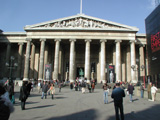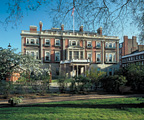Crown Jewels & Celebrity Gems
Originally published in January 2021 in American in Britain Winter 2020/2021
Spectacular jewels embody a history of how jewellers designed and developed the technical skills to turn precious and non-precious metals and gemstones into forms of adornment. Read about royal jewels and an Beyoncé’s exceptional celebrity ring .
CROWN JEWELS & CELEBRITY GEMS
By Abby Cronin
Feast your eyes on the mesmerising gemstones that sparkle in the V&A’s Bollinger Jewellery Gallery. Named for the Bollinger family who funded its opening in 2008, it is one of the most popular destinations in the V&A. A stunning refurbishment was completed in 2018 and today some 3,500 objects are displayed telling the story of 3,000 years of mainly Western jewellery. Since the re-opening 80 new additions have been installed in the permanent exhibition. The collection is presented in a long, tall, dimly lit rectangular gallery on two levels – a spiral staircase links them. Jewels are displayed in cases along the walls and in sculpted glass vitrines in the centre of the gallery space.
These spectacular jewels embody a history of how jewellers designed and developed the technical skills to turn precious and non-precious metals and gemstones into forms of adornment. Signage labels explain the role each piece has played historically. From the Bronze Age on through the Byzantine period and up to the present day, we learn what these jewels signify for a myriad of social, religious, political and cultural occasions.
A remarkable Bronze Age find is the mesmerising Shannongrove Goret collar (seen here) displayed prominently in the vitrine placed near the gallery entrance. It is not known whether it has any association with royalty. But it is a stunning example of a gorget, a crescent shaped ornament thought to have been used to fasten cloaks around the neck. It is hard to believe that this embossed gold collar was found in a bog in Shannongrove, Co. Limerick sometime before 1783 but it dates back to 800-700 BC. Described as a horseshoe collar, late Bronze Age, with chased and embossed decoration, it was probably used for ceremonial events. But if you didn’t know it was a Bronze Age discovery, you might recognise it as a familiar contemporary design for costume or precious jewellery often seen in high street shops today.
When the Bollinger gallery re-opened in 2018, important new additions were featured. One of the most outstanding acquisitions was a spectacular sapphire and diamond coronet designed by Prince Albert for Queen Victoria in 1840, the year they married.
Because the coronet was not a crown jewel and was part of Victoria’s personal collection, it passed down through her heirs. No one seems to know how it ended up with a London dealer in 2016. English law recognises that items regarded as national treasures cannot be removed from the country, so when the dealer applied for an export license and put it up for auction at $6.5-million, remarkably, this national treasure was saved for the nation and dramatically acquired for the V&A museum.
This coronet contains a wealth of royal history together with an ingenious design. Albert modelled the piece on the Saxon Rautenkranz, a circlet of rue flowers running on the diagonal across the Saxon coat of arms, with swooping detailing and finials at the top. Made by Joseph Kitching of Kitching and Abud, who were appointed “Jewellers to the Queen” in 1837, the detailing and finials are articulated and can be adapted to suit the fashion of the day. It can be worn closed or open-backed as a coronet or a tiara. Victoria wore the coronet in a famous portrait in 1842 by Franz Xaver Winterhalter, (pictured here) and again 20 years later during the opening Parliament as a coronet, a tribute to the recent death of her husband. This crown jewel is displayed in a bespoke vitrine. It is lit so that it appears to float inside the display case. It is the unique jewel of a young Queen Victoria.
Clink the link to the video which discusses and shows the coronet in pieces. https://www.youtube.com/watch?v=PeIbwV2CZbM
Since royalty and royal status have endured through the centuries, it is hardly surprising that our contemporary culture is full of celebrity ‘royals’. Although the lineage of some ‘royals’ may be dubious, many celebrity ‘royals’ get almost as much attention as the British royal family. Pop stars reign supreme in this category. Arguably, Beyoncé is to pop culture what Elizabeth II is to the United Kingdom: the undisputed queen of pop. Given Beyoncé’s ‘royal’ celebrity status, she, together with her husband Jay-Z, have indulged their taste for glamour and luxury. The couple enjoy commissioning bespoke jewels. How fortunate this is for the V&A. In 2014 her London-based jeweller Glenn Spiro designed the Papillon ring. A truly unique design, the ring is in the shape of a large butterfly poised to fly away. The wings of the butterfly are made of titanium, encrusted with emeralds and green tsavorite, a fashionable gemstone only recently discovered in 1967. When worn, the wings of the butterfly move as if in flight. (see it pictured here with Beyoncé) Do click on the link to Spiro’s video of how he designed the Papillon ring here: https://vimeo.com/327076972Beyoncé’s Papillon Ring
Fortunately for the V&A, the singer is enthusiastic about museums. She and Jay-Z gifted the Papillon ring to the V&A in 2018. Today it resides permanently in the Bollinger Gallery and is an exquisite example of contemporary jewellery design made by one of the UK’s master jewellers. Jewellery curator, Clare Phillips, was delighted to accept a gift from Beyoncé’s personal collection.
If you are curious to learn about what other royal jewels are held in the Bollinger Gallery, keep your eye open for pendants given by Elizabeth I to her courtiers. And seek out the exquisite diamond jewellery made by Leopold Pfisterer for Catherine the Great and sold by the Bolsheviks after 1917. Don’t miss the emerald and diamond necklace that Napoleon and Joséphine, his first wife, are believed to have given to their adopted daughter, Stéphanie de Beauharnais, for her arranged marriage in 1806. The more you look, the more royal connections you will find.
The Bollinger Gallery is the place to go to see centuries of exquisite historical and modern jewellery: ‘Crown jewels and Celebrity gems’ and myriad forms of jewelled adornment. More than 140 living goldsmiths and jewellers are represented in the gallery. Look for unique pieces by Tiffany, Lalique and Cartier. Find them sprinkled in the display cases. Over 140 living goldsmiths and jewellers are represented in the gallery. Which is to say: jewellery lovers will feel that no matter how many visits they make, they are bound to make a silent date with themselves to return. You could probably come 100 times and each time you will see something new. Before your visit. remember to check out the online links to the V&A video introduction to the Bollinger Gallery and the video discussion of how the Papillon ring was made. Online links are easily found on the V&A website and below.
Links:
https://www.youtube.com/watch?v=bqmRoDna0Qw
https://vimeo.com/327076972Beyoncé’s Papillon Ring
| All Images credit: ©Victoria and Albert Museum, London Email: artsjournalist@abbycronin.co.uk Get in Touch. Contact: Abby Cronin Website: abbycronin.co.uk |




